Method of manufacturing a medical device having a porous coating thereon
a technology of medical devices and porous coatings, applied in the direction of prosthesis, impression caps, catheters, etc., can solve the problems of drug particles being trapped in the polymer, affecting the release mechanism, and reducing the physical stability of the polymer
- Summary
- Abstract
- Description
- Claims
- Application Information
AI Technical Summary
Benefits of technology
Problems solved by technology
Method used
Image
Examples
example 1
[0038] Styrene-butadiene-styrene (SIBS) is dissolved in a 95:5 toluene:THF solvent, and paclitaxel is added to the solution. The resultant mixture is cooled to 80° F. Carbon dioxide particles in toluene are ground with a rolling ball mill until a dry ice slurry is formed containing micronized carbon dioxide solid particles. The slurry is mixed with the SIBS / paclitaxel / toluene:THF solution, and the resultant mixture is sprayed onto a stent at −80° F. The toluene:THF solvent is evaporated away under a vacuum (10 torr) at −80° F., leaving a porous SIBS coating containing carbon dioxide particles and paclitaxel suspended therein. The stent is exposed to room temperature to allow the carbon dioxide particles to evaporate.
example 2
[0039] Styrene-butadiene-styrene (SIBS) is dissolved in a THF solvent, and paclitaxel is added to the solution. CABOSIL™ is added to the SIBS / paclitaxel / THF solution. The resultant suspension containing the CABOSIL™ is placed on a rolling glass ball mill until there is even dispersion of the CABOSIL™. The suspension is drawn down onto a film and the solvent is evaporated at room temperature. The film has a uniform thickness of 20 micrometers when dry. The film is then cut into many coupons of identical dimension, which contain identical amounts of paclitaxel. The coupons are put into separate vials. Eluting media is injected into each vial, which is kept at a constant temperature (50° C.). After a fixed amount of time (24 or 48 hours), the eluting media is withdrawn from the vial and run through a High Performance Liquid Chromatography (HPLC) instrument, which quantitatively measures the amount of paclitaxel in the eluting media.
[0040] The foregoing description and example have bee...
PUM
| Property | Measurement | Unit |
|---|---|---|
| thick | aaaaa | aaaaa |
| thickness | aaaaa | aaaaa |
| thickness | aaaaa | aaaaa |
Abstract
Description
Claims
Application Information
 Login to View More
Login to View More - R&D
- Intellectual Property
- Life Sciences
- Materials
- Tech Scout
- Unparalleled Data Quality
- Higher Quality Content
- 60% Fewer Hallucinations
Browse by: Latest US Patents, China's latest patents, Technical Efficacy Thesaurus, Application Domain, Technology Topic, Popular Technical Reports.
© 2025 PatSnap. All rights reserved.Legal|Privacy policy|Modern Slavery Act Transparency Statement|Sitemap|About US| Contact US: help@patsnap.com

